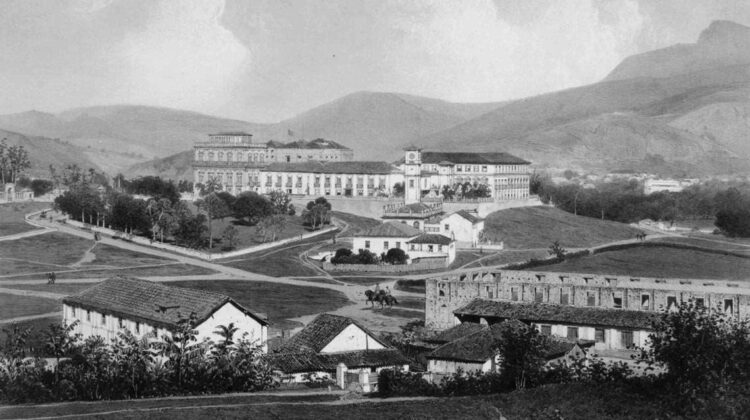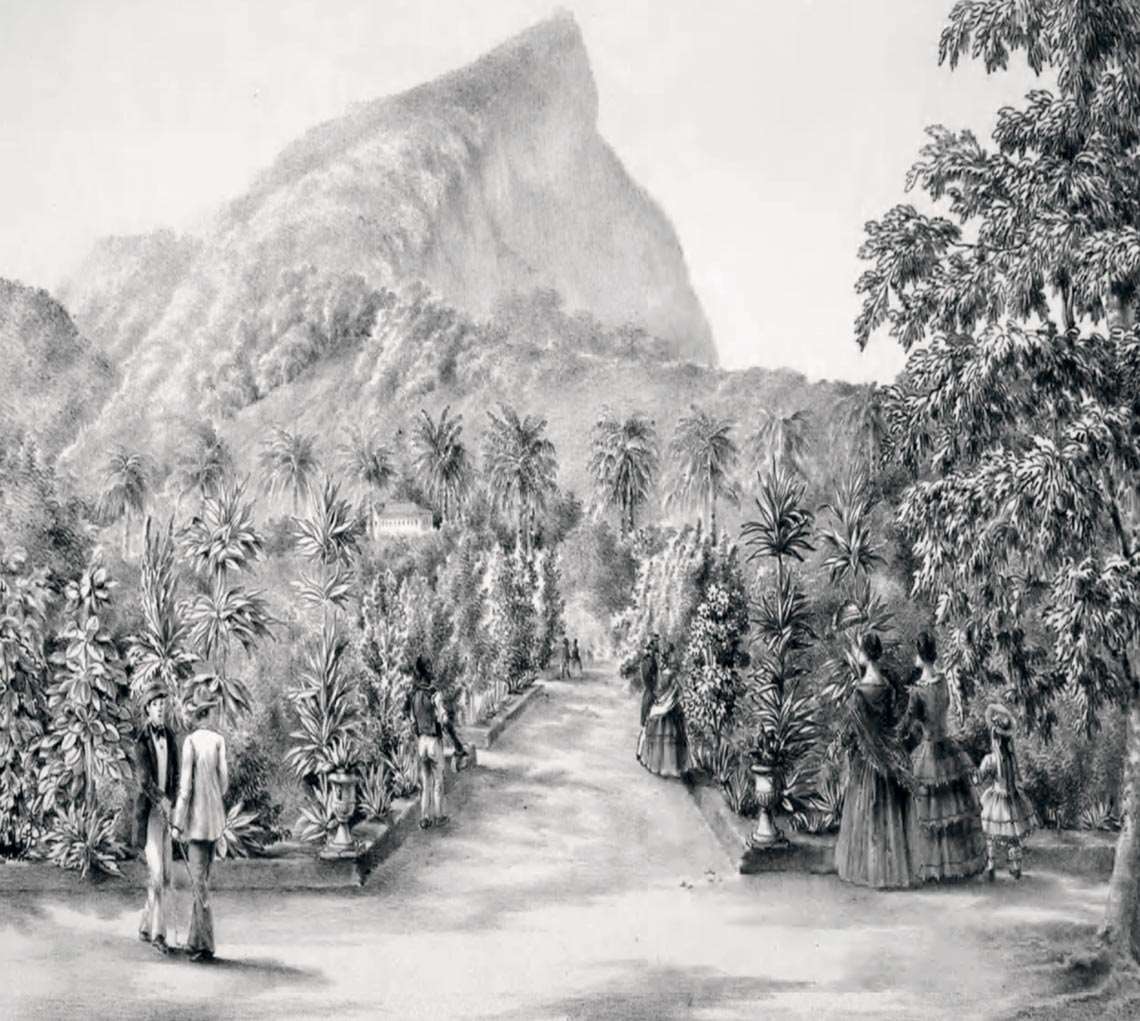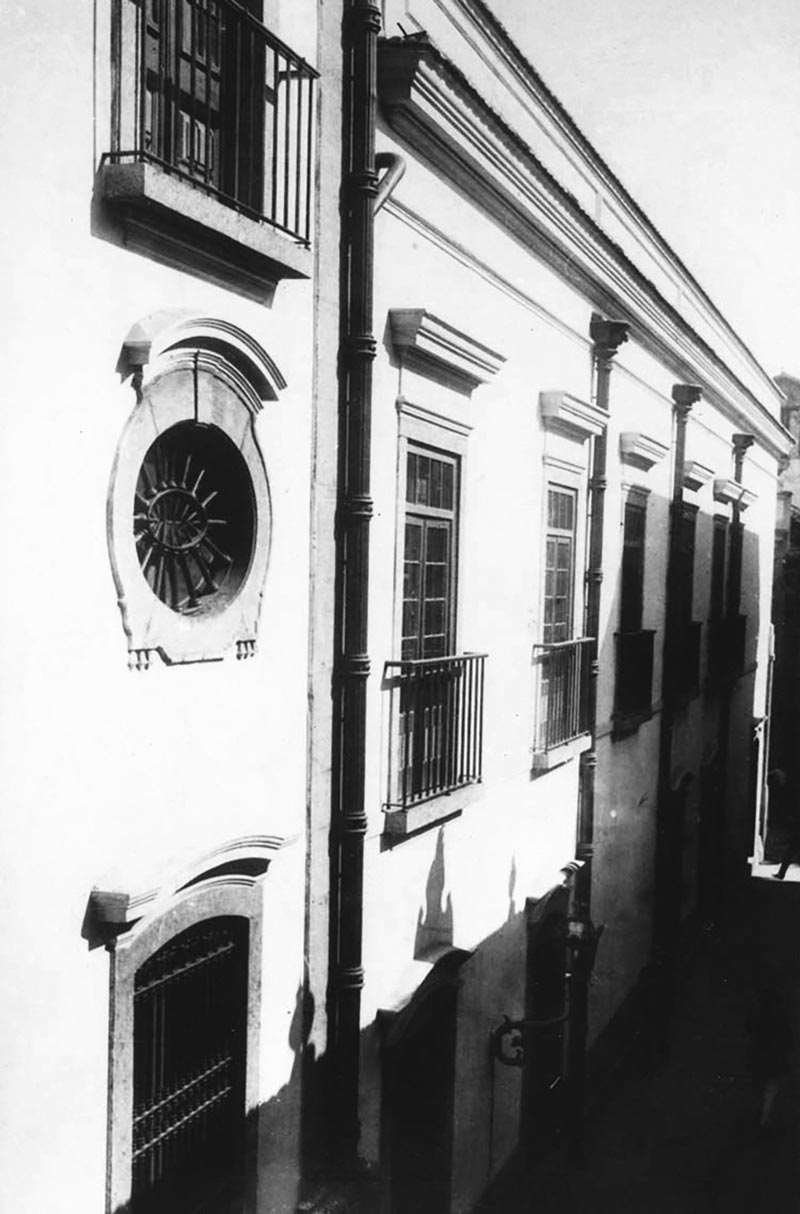
Science to help build a nation
The Royal Museum (group of buildings in the background), later renamed the National Museum, in an 1861 lithograph by Charles Ribeyrolles, based on a photograph by Victor FrondBrazilian National Library
Museums, research institutions, maps, and surveys of natural resources grew in importance in the Brazilian Empire
In addition to fighting off internal revolts and foreign invasions, founding villages, and expanding the population into the country’s interior, the viceroys who ruled Brazil between 1640 and 1808 created institutions and promoted geographic, mineralogical, and botanical surveys to facilitate management of the territory and earn more wealth for the Portuguese government. The fourth viceroy, Vasco Meneses (1673–1741), sponsored the colony’s first literary society, the Academia Brasílica dos Esquecidos (Brazilian Academy of the Forgotten), which operated for a year between 1724 and 1725. The twelfth, Luís de Vasconcelos e Sousa (1742–1809), created the Natural History Office of Brazil, better known as the House of Birds, in the center of the city of Rio de Janeiro in 1784, which gathered Brazilian animals for display or to send to the Royal Museum of Ajuda and rural properties in Portugal. The institution was the embryo of the Brazilian National Museum, which was formally established in 1818 as the Royal Museum.
On arrival in Brazil in 1808, the Portuguese Court brought with it scientific and cultural institutions that stimulated knowledge of the territory and circulation of information through newspapers that were beginning to be printed in Rio de Janeiro. “Creating scientific institutions was part of Dom João VI’s strategy to transform the city of Rio into the seat of the Court,” highlights science historian Maria Amélia Mascarenhas Dantes, a retired professor at the School of Philosophy, Languages and Literature, and Humanities at the University of São Paulo (FFLCH-USP).
Íris Kantor, a historian from FFLCH, notes that the latest research validates the pioneering studies of historian Maria Odila Leite Silva Dias, a retired professor at USP. In one study, published in Revista IHGB (published by the Brazilian Historic and Geographic Institute) in 1968, Dias comments: “The role of state policy in this scholarly movement, mostly dedicated to natural sciences, deserves particular acknowledgement due to its multiple implications, both in guiding studies and in the mentality of the politicians involved in the independence process.”
In the study, she observes the pragmatism of the Portuguese government in promoting botanical and mineral surveys—encouraged since the late eighteenth century by the Portuguese statesman and Marquis of Pombal, Sebastião José de Carvalho e Melo (1699–1782), with the objective of finding products of commercial value. “Science of this kind was standard practice for European countries in the Age of Enlightenment,” reiterates Silvia Figueirôa, a geologist from the School of Education at the University of Campinas (FE-UNICAMP), referencing the cultural movement led by France in the eighteenth century.
In 1818, the Portuguese Court created the Royal Museum with the aim of “propagating the knowledge and study of the natural sciences in the Kingdom of Brazil, in which are to be found thousands of objects worthy of observation and examination and which may be useful to commerce, industry, and the arts,” according to the decree issued upon its inauguration. Brazilian National LibraryThe Botanical Garden of Rio de Janeiro in an 1856 drawing by Pieter Godfred BertichemBrazilian National Library
Brazilian National LibraryThe Botanical Garden of Rio de Janeiro in an 1856 drawing by Pieter Godfred BertichemBrazilian National Library
The power of maps
“Science, especially cartography, was part of the Portuguese Empire’s survival strategy in terms of strong inter-imperial competition,” says Kantor, one of the curators of an exhibition of old maps at the Naval Museum in Rio de Janeiro (see article). “The maps helped develop the imagined idea of Brazil and the notion of a cohesive and integrated territory. They were also used for population management, by indicating places where goods could be taxed.”
According to Kantor, Portugal supported scientific activities and institutions to “create a positive image of colonization, assuaging accusations of violence against indigenous people made by other European nations, and to demonstrate its control over the territory.” This is true of the New Lusitania map, completed in 1798 by the astronomer and frigate captain Antonio Pires da Silva Pontes Leme (1750–1805).
Adopting the island of El Hierro in the Canaries as longitude 0 (the Greenwich meridian was only recognized as international standard in 1884), the map details the networks of rivers, islands, mountains, settlements, indigenous villages, forts, land routes, and gold mines in Brazil. Together with historian Beatriz Bueno of USP’s School of Architecture and Urbanism (FAU), she located documents indicating that Portuguese diplomats presented New Lusitania to peers in London with the intent of demonstrating Portugal’s sovereignty and scaring away anybody interested in exploiting the riches of Brazil.
Lorelai Kury, a historian from the Oswaldo Cruz House at the Oswaldo Cruz Foundation (COC-FIOCRUZ) in Rio de Janeiro, points out that unlike his wife Empress Leopoldina (1797–1826), Dom Pedro I (1798–1834) had little interest in science, although he still recognized its value. According to Kury, this was one of the reasons why in 1831, he chose José Bonifácio de Andrada e Silva (1763–1838)—a statesman, naturalist, and mineralogist—to tutor his son, the future emperor Dom Pedro II (1825–1891). Brazilian National LibraryThe first building of the National Library, on Rua do Carmo, Rio de JaneiroBrazilian National Library
Brazilian National LibraryThe first building of the National Library, on Rua do Carmo, Rio de JaneiroBrazilian National Library
Self-taught scientists
“Until the second half of the nineteenth century, when they began to position themselves as producers of science, these institutions had little influence compared to the individuals who produced scientific knowledge,” stresses Kury. There were two groups of scientists: a few professionals employed by the government or institutions, and the amateurs, usually self-taught, who had to earn a living from another profession or did not need to work. “It was like that in other countries as well,” notes Figueirôa. “The chemist Antoine Lavoisier [1743–1794] was executed by guillotine because he was a tax collector under the Old Regime.”
Officials of the Portuguese Crown in Brazil, for example, included three German geologists: Wilhelm Ludwig von Eschwege (1777–1855), Wilhelm Christian Gotthelf von Feldner (1772–1822), and Friedrich Ludwig Wilhelm Varnhagen (1782–1842). The trio worked as mine inspectors and carried out mineralogical surveys in the country for more than a decade, until 1821 (see Pesquisa FAPESP issue nº 317).
Among the amateurs were many religious people. In 1783, José Mariano da Conceição Veloso (1742–1811), better known as Friar Veloso, led an expedition into the forest near Rio de Janeiro that lasted four years and resulted in the book Flora fluminensis, published posthumously in 11 volumes from 1825 to 1831, describing 1,626 plant species grouped into 396 genera (see Pesquisa FAPESP issue nºs. 172 and 289). Between 1824 and 1829, Leandro do Santíssimo Sacramento (1778–1829), a Carmelite friar and botanist from Pernambuco who studied philosophy at the University of Coimbra in Portugal, was director of Rio de Janeiro’s Botanical Garden, the second in Brazil, created in 1808—the first was in Belém, Pará, instituted in 1796 by royal decree from Queen Maria I (1734–1816). Both botanical gardens served the purpose of acclimatizing exotic plant species for cultivation in Brazil, or native species for commercial production.
Falling somewhere in between—self-taught but paid for his work—was a taxidermist called Francisco Xavier Cardoso Caldeira (?–1810) who ran the House of Birds for 20 years. In an article published in the journal Filosofia e História da Biologia in 2018, three researchers from Rio de Janeiro State University (UERJ)—Bruno Absolon, Francisco Figueiredo, and Valéria Gallo—reported that Caldeira slept at the museum and had three servants, two assistants, and two hunters, who added to the collection by shooting birds at a lake in front of the institution which he then stuffed. The museum closed in 1813 and what survived of the collection, which stood at almost 1,000 animals, remained in the country’s armory until 1818, when it was transferred to the newly founded Royal Museum (see Pesquisa FAPESP issue nº 272).
The Portuguese government asked specialists to look for places to mine saltpeter, a mineral used to make gunpowder, as well as plants with commercial value. One was José Vieira Couto (1752–1827), who had a degree in mathematics from Coimbra and was hired by the crown to identify mineral sources that could be exploited, as described in an article published by Dantes in the journal Science and Culture in 2005.
The first native doctors
Based in Rio, the Portuguese Court also tried to increase the number of medical specialists, previously only trained in Europe, by establishing the Bahia School of Surgery in Salvador and the Anatomical, Surgical, and Medical School of Rio de Janeiro, both in 1808 (see timeline). It thus established medical practice in Brazil, hitherto provided by barbers, bleeders, practitioners, and healers, noted COC-FIOCRUZ historian Flávio Coelho Edler in a 2009 article in the journal Acervo. At that time, there was still competition between specialists: doctors whose training was supported by the government had to compete for clients with healers who offered protection against virtually any disease. “Most people preferred healers because they made more sense in their world,” he says. In 1832, a decree transformed the medical schools in Rio de Janeiro and Bahia, removing the surgery course and allowing students to graduate in one of three areas—medicine, pharmacy, or childbirth—in line with the French model for medical education.
The Medical Society of Rio de Janeiro, formed in 1829 and six years later renamed the Imperial Academy of Medicine, not only helped modernize medicine in Brazil, it also advised the government on strategies for improving hygiene in cities and preventing the spread of diseases, such as moving cemeteries and slaughterhouses farther from residences and draining swamps. Based on areas of expertise such as geography or climatology, doctors examined the relief, winds, temperature, humidity, and even the incidence of lightning, because it was believed that diseases resulted from evil influences in the air and certain places.
“At the time, people believed that to avoid getting sick, you not only had to live in a healthy place, but also to live in moderation, without uncontrollable passions or excesses,” says Edler. “It was believed that frugal people lived longer.” This view began to change in the second half of the nineteenth century with the discovery of disease-causing microbes by German pathologist Robert Koch (1843–1910) and French chemist Louis Pasteur (1822–1895).
A more national science?
In 1724, the elite of Salvador founded the Academia Brasílica dos Esquecidos (Brazilian Academy of the Forgotten) and in 1759 the Academia dos Renascidos (Academy of the Reborn) to discuss and document the history of Portuguese America. Pombal, however, banned the Academy of the Reborn, fearing that its members would forge unwanted alliances with foreign academics. When the Portuguese Court was transferred to Rio de Janeiro, the Royal Maritime and Military Society, comprising engineers, astronomers, and mathematicians, brought its extraordinary collection of maps of the Portuguese territories, which were part of the Royal Military Archive.
“The Royal Society was established in Portugal by the Count of Linhares and Secretary of State for Foreign Affairs and War, Dom Rodrigo de Sousa Coutinho [1755–1812], to produce knowledge that would be useful to state policies, such as reforming the navy, increasing terrestrial and coastal communications, and creating an official postal system,” says Kantor. In an article published in Araucaria – Revista Iberoamericana de Filosofía, Política y Humanidades (Iberoamerican journal of philosophy, politics, and humanities) in 2010, she wrote: “The cartographic projections devised by enlightened Portuguese reformers constituted an instrument of governability of the future Empire of Brazil.”
But little by little—especially after Brazil’s independence, notes Kury—science became more appreciated nationwide. In April 1835, in the first issue of the medical journal Revista Médica Fluminense, later renamed Revista Médica Brasileira, Joaquim Candido Soares de Meirelles (1797–1868), one of the founders of the Rio de Janeiro Society of Medicine, highlighted that Brazilian medicine owed much to France and commented: “Brazilian doctors need to come together; we all need to work in common agreement so that one day Brazilian medicine can be recognized in its own right, especially since we are better than anyone in such a vast field of highly interesting medical discoveries.”
Opinions like this were rare in medical journals, which prioritized articles on newly discovered diseases, treatments, or news from other countries. There were also newspapers, such as O Patriota, directed by Manuel Ferreira de Araújo Guimarães (1777–1838), a navy soldier and astronomy professor. Published by Imprensa Régia, considered the first company to publish news about science—as well as literary and political articles, like most publications in the nineteenth century—the newspaper circulated between January 1813 and December 1814 (see Pesquisa FAPESP issue nº 100).
One exception was the magazine O Auxiliador da Indústria Nacional, which was in print for 59 years, from 1833 to 1892, publishing monthly issues with an average length of 32 pages and circulation of 600 to 2,500 copies. O Auxiliador reported on the planting of cassava, sugarcane, wheat, and annatto, the use of machinery in agriculture, and the treatment of diarrhea in cattle, reproduced from other Brazilian titles, such as O Patriota or translated from foreign sources, such as The American Farmer (USA) and the Journal of Useful Knowledge (France).
The first of the magazine’s 12 editors was Januário da Cunha Barbosa (1780–1846), a clergyman, historian, poet, and politician from Rio de Janeiro who supported Brazilian independence. He was succeeded by other men with academic backgrounds, such as magistrate and historian Baltasar da Silva Lisboa (1761–1840); physician Emílio Joaquim da Silva Maia (1808–1859); and two directors of the National Museum—botanist and mineralogist Frederico Leopoldo Cezar Burlamaqui (1803–1866) and physician Nicolau Joaquim Moreira (1824–1894).
The magazine reported on the lectures and meetings of its financial backer, the Auxiliary Society of National Industry (SAIN). Formed in 1831, the society brought together farmers, merchants, professionals, naturalists, politicians, public officials, the military, and religious figures that wanted to diversify the economy beyond agriculture. It offered courses, established a night school for adults, and helped found the Brazilian Historic and Geographic Institute in Rio de Janeiro in 1838—the first to be founded in the country—which published original articles and advised on public policy.
With support from the imperial government, SAIN organized the First National Exhibition of Industry in the Empire of Brazil in 1861, held at the Engineering School (later renamed the Polytechnic School and incorporated into the Federal University of Rio de Janeiro) in the center of the state capital.
In a chapter of the book Espaços da ciência no Brasil: 1800–1930 (Science spaces in Brazil: 1800–1930; Editora Fiocruz, 2001), science historian Heloisa Maria Bertol Domingues of the Museum of Astronomy and Related Sciences (MAST) states that the importance of the society’s work was recognized by the Viscount of Macaé, José Carlos Pereira de Almeida Torres (1799–1856), in 1848. “He highlighted periodicals that published discussions on various issues related to agriculture and industry,” says the researcher. “That, for him, was the first step toward reducing the number of workers needed or replacing them with machines.” Kantor, from USP, notes: “The society’s activities were directly linked to the Portuguese tradition of valuing applied science and using knowledge to reform and innovate.”
Scientific articles
ABSOLON, B. A. et al. O primeiro gabinete de história natural do Brasil (“Casa dos Pássaros”) e a contribuição de Francisco Xavier Cardoso Caldeira. Filosofia e História da Biologia. vol. 13, no. 1, pp. 1–22. 2018.
DANTES, Maria A. M. As ciências na história brasileira. Ciência e Cultura, vol. 57, no. 1, pp. 26–8, 2005.
DIAS, M. O. L. S. Aspectos da ilustração no Brasil. Revista do Instituto Histórico e Geográfico Brasileiro. vol. 276, pp. 105–70. jan.–mar. 1968.
EDLER, F. C. A natureza contra o hábito – A ciência médica no Império. Acervo. vol. 22, no. 1, pp. 153–66. jan.–june 2009.
KANTOR, I. Mapas em trânsito: Projeções cartográficas e processo de emancipação política do Brasil (1779-1822). Araucaria – Revista Iberoamericana de Filosofía, Política y Humanidades. vol. 12, no. 24, pp. 110–23. aug.–dec. 2010.
KURY, L. Homens de ciência no Brasil: Impérios coloniais e circulação de informações (1780–1810). História, Ciências, Saúde Manguinhos. vol. 11, no. 1, pp. 109–29. 2004.
PIZA, A. T. Ao leitor. Revista do Instituto Histórico e Geográfico de São Paulo. vol. 1, pp. 1–2. 1895.
Books
DANTES, M. A. M. (org.) Espaços da ciência no Brasil: 1800-1930. Rio de Janeiro: Editora Fiocruz, 2001.
EDLER, F. C. Ensino e profissão médica na corte de Pedro II. Santo André: Universidade Federal do ABC, 2014.
This work first appeared on Pesquisa FAPESP under a CC-BY-NC-ND 4.0 license. Read the original here.
var img = new Image(); img.src=’https://revistapesquisa.fapesp.br/republicacao_frame?id=455388&referer=’ + window.location.href;
